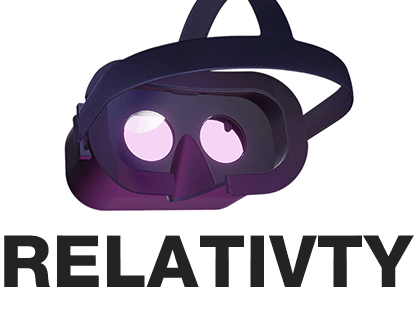I’m Max Coutte and when my best friend Gabriel Combe and I were 15 years old we built our own VR headset because we couldn't afford to buy one.
5 years later : this headset became Relativty.
- Fully open-source - hardware, software, firmware.
- SteamVR support.
- Natively displays 2K resolution at 120FPS.
- Compatible with Arduino.
- Experimental body-tracking.
This repo serves as a Build guide, to learn more about the headset see you at Relativty.com
Made for HackersRelativty is not a consumer product. We made Relativty in my bedroom with a soldering iron and a 3D printer and we expect you to do the same: build it yourself.
To learn more about the features of the Firmware, Software and Hardware visit the website. We also have a friendly Discord server, a place for our community to learn, share their knowledge, and ask for help. All the links are at relativty.com.
Start Building Relativty
Building The Hardware
The hardware is based on the Relativty Motherboard which includes an Atmel SAM3X8E ARM Cortex-M3 processor and uses an MPU-6050 as it’s IMU.Alternatively, any processor that supports the ArduinoCore and is connected to an MPU-6050 can be used as the hardware for Relativty. Both methods are explained below.
Building The Relativty MotherboardPCB Manufacturing.We first start with the naked PCB.
it can be manufactured and bought for around $4 on websites like jlcpcb.
You’ll need to provide the Gerber file folder Relativty_Electronics_build/GerberFiles.zip which describes the shape of the board.
Soldering the components onto the naked PCB.
You’ll have to buy the components listed in one of the two BOMs, depending on availability:
Relativty_Electronics_build/Assembly/jlcpcb.com_motherboard_BOM.csvRelativty_Electronics_build/Assembly/motherboard_BOM.xlsx
Where to position those components on the PCB is described in the file Relativty_Electronics_source/motherboard.brd which can be opened in Eagle.
An alternative to the Relativty Motherboard is to use an Arduino Due and to connect it to an MPU-6050.
5V -> VCC
GND -> GND
SDA(20) -> SDA
SCL(21) -> SCL
PIN 2 -> INTThen push the ERASE and the RESET button on the Arduino Due and you’ll be able to install the Relativty Firmware.
You’ll now need to install the Relativty board in the Arduino IDE.
To do that copy that JSON URL: https://raw.githubusercontent.com/relativty/Relativty/master/Relativty_Firmware/package_Relativty_board_index.json and open the Arduino IDE
In Arduino, Click File and then Preferences:
Add the JSON URL to the Additional Boards Manager text box.Go to Tools > Board > Board Manager and you should see the Relativty Board, click install.You can now open Relativty_Firmware/firmware/firmware.ino and upload it to your board.
- Reboot the Arduino IDE and under Tools > Boards, select Relativty.
Building The Mechanical Parts
Assembling the HMDAll the files needed for the 3D printing can be found in the Relativty_Mechanical_build folder and the screws needed to assemble the Headset are listed in screws_BOM.xlsx.
We've used parts from Aliexpress:
The screen for the HMDRelativty Headset runs a dual-screen at 120FPS 2K, however, because of the open nature of Relativty you can equip it with any screen.
Our model can be found on Aliexpress, but depending on the vendor similar screens can cost from $150 to $190. You'll have to hunt and maybe wait for the right vendor at the right price to get the display for cheap (or buy in bulk).
This is the model we used.
Setting Up the SoftwareThe Relativty Driver is contained within Relativty_Driver/Relativty folder.
⚠️ You’ll need to set it up by editing the JSON file Relativty_Driver/Relativty/resources/settings/default.vrsettingsbefore you install it.
Start by setting windowX and windowY to the x and y resolution of your main display. For instance,
"windowX" : 1920,
"windowY" : 1080,Make sure in your Windows settings that the Relativty’s display is in landscape mode, located at the right of your main display and with theirs tops aligned horizontally.
Then, set windowWidth, windowHeight, renderWidth, and renderHeight to the resolution of your Relativty Display.
For instance,
"windowWidth" : 2880,
"windowHeight" : 1440,
"renderWidth" : 2880,
"renderHeight" : 1440,You can now install Relativty Driver:
Locate your vrpathreg.exe program, usually located at C:/Steam/steamapps/common/SteamVR/bin/win64/vrpathreg.exeThen open the Windows Command Prompt and run the following commands: cd C:/Steam/steamapps/common/SteamVR/bin/win64 vrpathreg.exe
And then assuming your Relativty_Driver/Relativty driver folder is located at: C:/code/Relativty_Driver/Relativty
run vrpathreg adddriver C:/code/Relativty_Driver/Relativty
Relativty Driver is now installed. You can uninstall it any time by running:
vrpathreg removedriver C:/code/Relativty_Driver/Relativty
The tracking is still very experimental and can only be run on NVIDIA GPU due to the usage of CUDA. The tracking makes uses of only a video input and an Artificial Neural Network AI trained to estimate a 3D body position.
This method is nothing close to the precision or freedom of movements of a dedicated sensor however we believe that the model can be trained and improved by orders of magnitude.
You first need to connect a webcam to your computer and install Python 3.8.4 and select the option to add it to the path. Then install PyTorch, you can do so by running the following commands:
python -m pip install torch===1.6.0 torchvision===0.7.0 -f https://download.pytorch.org/whl/torch_stable.html
Then proceed to install CUDA Toolkit 11.0.
You’ll then need to download the Folder PYTHONPATH at https://github.com/relativty/Relativty/releases and add its location to PyPath in the JSON Relativty_Driver/Relativty/resources/settings/default.vrsettings
Set tracking to 1. The tracking is now turned on and can be turned off anytime by setting tracking to 0.
Everything is now set up to start playing.
To start using Relativty:
- Lay the headset on a flat surface with the front panel facing the ground
- Plug in the headset. It’ll automatically calibrate after a few seconds.
You can now run any SteamVR game!
Max Coutte, Gabriel Combe











Comments
Please log in or sign up to comment.